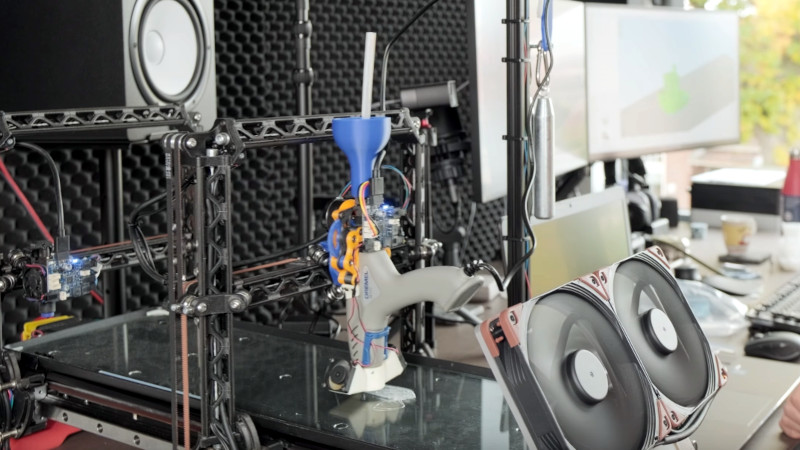Face it, we’ve all at some time or other looked at our hot glue guns, and thought “I wonder if I could use that for 3D printing!”. [Proper Printing] didn’t just think it, he’s made a working hot glue 3D printer. As you’d expect, it’s the extruder which forms the hack here.
A Dremel hot glue gun supplies the hot end, whose mains heater cartridge is replaced with a low voltage one with he help of a piece of brass tube. He already has his own design for an extruder for larger diameters, so he mates this with the hot end. Finally the nozzle is tapped with a thread to fit an airbrush nozzle for printing, and he’s ready tp print. With a much lower temperature and an unheated bed it extrudes, but it takes multiple attempts and several redesigns of the mechanical parts of the extruder before he finally ended up with the plastic shell of the glue gun as part of the assembly.
The last touch is a glue stick magazine that drops new sticks into a funnel on top of the extruder, and it’s printing a Benchy. At this point you might be asking why go to all this effort, but when you consider that there are other interesting materials which are only available in stick form it’s clear that this goes beyond the glue. If you’re up for more hot glue gun oddities meanwhile, in the past we’ve shown you the opposite process to this one.















Forrest Mims was doing this back in the 1980s, long before anything resembling a commercial 3-D printer existed. He talked about using hot glue guns, moved around in x-y by motors made from rewired car alternators. He called them “Santa Claus machines”.
Hahah I like the sourcing of the (extremely massive and clunky) motors, made sense in the 1980s
Did you mean to say Don Lancaster? (tinaja.com)
That’s where I first heard the term, but he didn’t coin it:
https://en.wikipedia.org/wiki/Santa_Claus_machine#Origin
Apparently, yes. :-)
Extremely impressed with the results produced, that was far better than expected. Obviously he knows what he’s doing.
Buying literally any step up from the $10 elementary school glue gun would vastly improve things. Glue guns have tiers, and if you shell out for one it will have much better tolerances and consistency. Like the nozzle tolerances so important for 3d printing, to make sure that exactly the right amount of actual melted plastic and not air is expelled per turn of the extruder, and that nothing dribbles out when it’s not turning.
I’m sure he knows this but perhaps he doesn’t know about the fancy glue guns. My Arrow glue gun also comes with sweet rocket fins on the back and looks like it shoots laser beams
Cool, stick with it!
The first RepRap prototype used a hot glue gun: https://www.reprap.org/wiki/RBS_Overview#Motivation
I remember seeing a printer, think it was a Stratsys one being demoed that took sticks of material in a similar way and printed in FDM style, but the material was sinterable metal, so you bake it in a kiln and it shrinks by a known amount as the binder burns off and the metal particles fuse leaving a fully metal part.
There’s regular FDM filament like this too. I don’t know if anyone uses it though, lol. Never saw a piece made with it
Cheap crayons -> Investment casting
Need to work on an automated paper label remover 🤔
A razor blade slitting the wrapper, and a nearly circular scraper to peel it off?
I think I have seen or heard of a similar concept but using glass rods instead.
When I’m trying to explain how an FDM printer works to someone non-technical, I often compare it to a ‘hot-glue gun, but smaller and with plastic instead of glue’